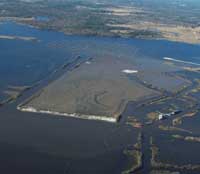|
Restoration in Jefferson County, Texas
Working with Our Partners to Increase Benefits
The Bailey Waste Disposal site was an active industrial waste disposal site in the 1950's and 1960's. The National Oceanic and Atmospheric Administration (NOAA) and the Texas trustees worked with the Environmental Protection Agency (EPA) to determine necessary remedial action for the site. The cleanup was completed in August 1997. Simultaneously, the trustees worked with the potentially responsible parties (PRPs) to settle the natural resource damage claims related to the site. The trustees reached a cooperative settlement to resolve natural resource damage liability for the site in December 1998. The Bailey site PRPs chose to provide $495,000 to construct the estuarine wetlands at the old Bessie Heights location.
 |
|
Completed beneficial dredged material project.
|
In December 2002, NOAA, as Lead Administrative Trustee, and the Texas natural resource trustees (Texas Commission on Environmental Quality, Texas Parks and Wildlife, Texas General Land Office and U.S. Fish and Wildlife Service), finalized the Restoration Plan/Environmental Assessment for the Bailey Waste Disposal Site, Bridge City, Texas.
The selected alternative was creation of 28 acres of reedgrass (Spartina alterniflora) dominated estuarine wetland at the Nelda Stark Unit of the Texas Parks and Wildlife's Lower Neches River Wildlife Management area, in nearby Jeffereson County.
The trustees also partnered with the Jefferson County Navigation District (JCND) to have it serve as the local sponsor of the project. NOAA, JCND, and the trustees then worked with the U.S. Army Corps of Engineers to secure Water Resources Development Act Section 204 matching funds to nearly quadruple the area of marsh created to more than 100 acres (now known as the Bessie Heights Project).
The Corps of Engineers completed dredged material placement in November 2003. Planting of the newly created wetlands, to enhance vegetative diversity, was finished in November 2004. In a March 2005 site visit, the trustees confirmed the success of the Spartina plantings and recolonization.
NOAA, working with our co-trustees continues to seek partnership opportunities. The local navigation district (JCND), based on this project's success, intends to work further with co-trustees to develop beneficial use projects in its area of operations. This will reduce costs of maintenance dredging by reducing the need for confined sediment disposal. In this area of Texas, there are large areas of subsided wetlands where projects similar to the Bessie Heights project could be constructed. Using dredge material to create wetlands, rather than disposing of it in confined sediment disposal, saves the port money and also creates habitat that provide benefits to fish and wildlife.
For more information on this project:
|
|
|
|


